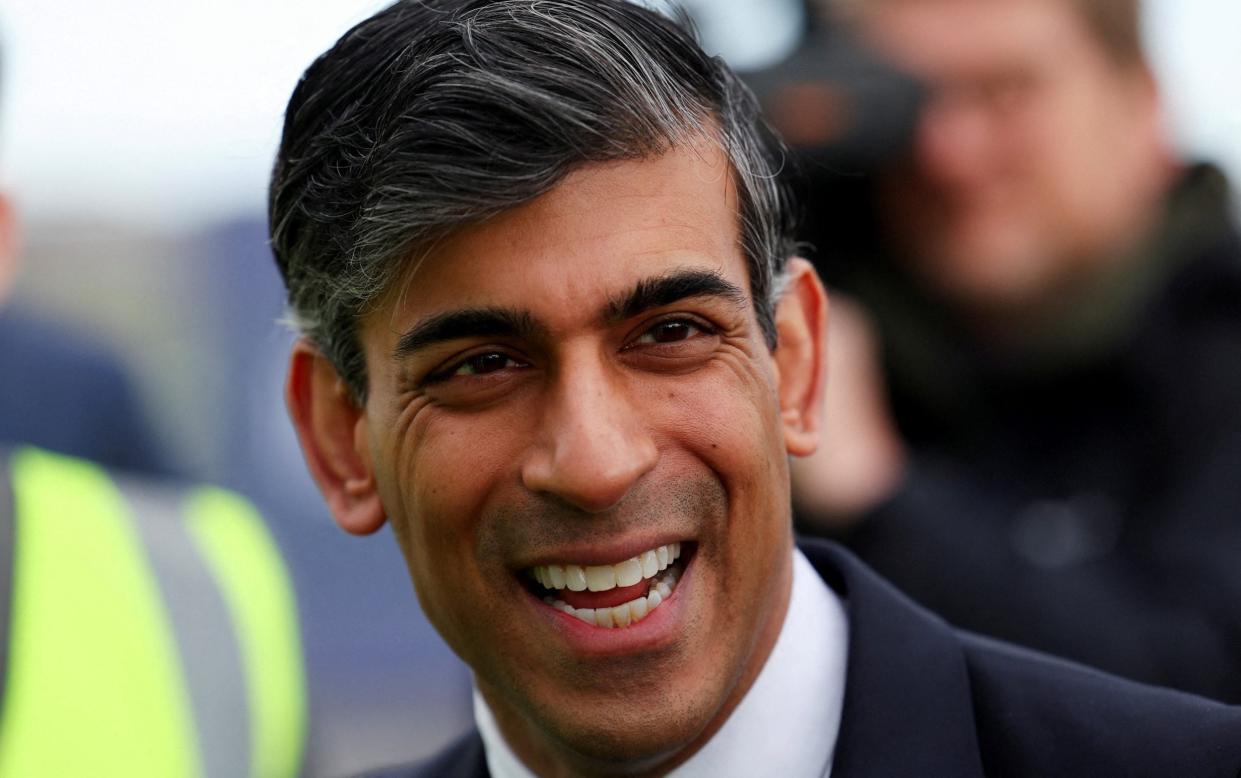Sunak’s post-recession victory lap may prove short-lived

- Oops!Something went wrong.Please try again later.
Wounded by local election losses and defecting Tory MPs, Rishi Sunak is trying hard to gain some kind of influence over the political narrative.
That’s why the Prime Minister spent much of Friday talking about newly released GDP figures which showed that the UK economy has, unequivocally, returned to growth.
The economy shrank 0.1pc between July and September last year and 0.3pc from October to December, with the Office for National Statistics (ONS) confirming the UK spent the last half of 2023 in recession – that is, two successive quarters of GDP contraction.
But figures released Friday morning showed the British economy bouncing back – with growth hitting 0.6pc between January and March compared to the previous quarter, and preliminary numbers adding another 0.4pc GDP expansion during April.
“We’ve turned the corner,” Sunak told me, when I interviewed him at a Siemens factory on the outskirts of Oxford. “This is the strongest growth the UK has seen in two years – our plan is working”.
The Prime Minister is right. Britain’s 0.6pc first-quarter growth, higher than the consensus forecast among City economists, is the sharpest uptick since the UK surged after coming out of lockdown.
During the back end of last year, the economy struggled and shrank slightly as stubbornly high inflation combined with elevated interest rates to weigh down both consumer and business sentiment.
Since then, inflation has fallen sharply – although at 3.2pc during the year to March, it remains above the Bank of England’s 2pc target. That’s one reason why the Monetary Policy Committee (MPC) on Thursday kept the Bank’s base borrowing cost at a 16-year high of 5.25pc – where it has been since last August.
Inflation has come down enough though – it was 6.7pc as recently as last September – for Governor Andrew Bailey to now suggest that borrowing costs “could be cut during the coming quarters”.
That combination of renewed GDP growth and concrete signs that interest rates will soon fall is a boost for Sunak, who last year made economic growth one of his five key pledges – and whose party remains some 20 points behind Labour in opinion polls.
News that the economy is now “going gangbusters” – in the words of one senior ONS official – doesn’t mean the Tories look likely to reverse Labour’s lead and win the general election, expected in October or November.
But if the MPC opts to cut rates once or twice before polling day, and the Government squeezes in another tax cut – perhaps lowering employee National Insurance for a third time, after reductions in January and April – there may be the makings of some kind of “feelgood factor”.
Millions of UK households have suffered badly during this cost of living squeeze – and many are hurting still. But if the economy really gets going then, for all the chaos of recent years, the Tories may limit the damage and make at least some inroads into Labour’s seemingly inevitable parliamentary majority.
That’s why shadow chancellor Rachel Reeves, mindful that warm words from the MPC and chunky growth numbers were in the pipeline, gave a press conference in the City on Wednesday, accusing ministers of “gaslighting the public on the economy”.
The term “gaslighting” – popular among teenagers and young adults these days, particularly when shouting at their parents, in my experience – derives from Patrick Hamilton’s 1938 play Gaslight, made into a 1944 film starring Ingrid Bergman, in which a man secretly dims and brightens the indoor gas-powered lighting while insisting his wife is imagining it, making her think she is going insane.
So ahead of decent economic news, Reeves got in her rebuttal first – what New Labour spin-doctors used to call “prebuttal” ahead of the 1997 election, in which Tony Blair won a landslide 179-seat majority and John Major’s Tory administration was crushed – knowing signs of recovery were in the works.
Pre-emptively accusing ministers of “running victory laps just because interest rates might come down soon and the economy isn’t shrinking anymore”, Reeves said “the Tories are woefully out of touch if they think countless hard-working families are sensing any feelgood factor”.
These words, Sunak told me on Friday, were “typical Labour, running down the country, with nothing constructive to say”.
The ONS fine print contains, though, data that Reeves and her team may find useful, as they try to convince us all that “this recovery isn’t real”.
The UK population has clearly increased sharply in recent years, due to a big rise in arrivals from outside the European Union. Net immigration soared to 745,000 in 2022 – more than the population of Leeds – up from less than 50,000 a year back in the late 1990s and less than 200,000 as recently as 2018.
When the low GDP growth of recent years – not just during lockdown but since the 2007 financial crisis, from which our economy, the entire global economy, never properly recovered – is combined with high population growth, then GDP per head often falls.
During the first three months of this year, GDP was up 0.6pc compared to the final quarter of 2023, as Sunak told us. But when inflation and a rising population are taken into account, real GDP per head rose by just 0.4pc, having contracted for the previous seven quarters.
When compared to the first quarter of 2023, real per head GDP, a far better measure of living standards than plain old GDP, was actually 0.7pc lower than a year ago.
While recession is over, that explains why so many UK households, ravaged by price rises while competing with countless new entrants for lower-wage jobs and heavily reliant on increasingly stretched public services, aren’t sensing much economic improvement in their lives.
If the economy is going to help the Tories make a fist of this election, there needs to be a lot more “recovery” yet.

